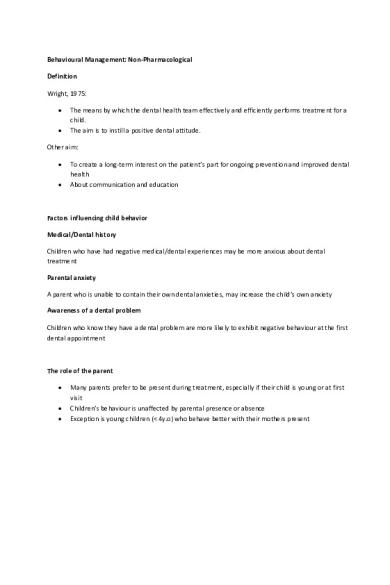Non Pharmacological Behavioural Management PDF

| Title | Non Pharmacological Behavioural Management |
|---|---|
| Course | Medical Doctor |
| Institution | Universiti Putra Malaysia |
| Pages | 4 |
| File Size | 84.5 KB |
| File Type | |
| Total Downloads | 3 |
| Total Views | 136 |
Summary
Psychological Intervention in Medicine...
Description
Behavioural Management: Non-Pharmacological Definition Wright, 1975:
The means by which the dental health team effectively and efficiently performs treatment for a child. The aim is to instill a positive dental attitude.
Other aim:
To create a long-term interest on the patient’s part for ongoing prevention and improved dental health About communication and education
Factors influencing child behavior Medical/Dental history Children who have had negative medical/dental experiences may be more anxious about dental treatment Parental anxiety A parent who is unable to contain their own dental anxieties, may increase the child’s own anxiety Awareness of a dental problem Children who know they have a dental problem are more likely to exhibit negative behaviour at the first dental appointment
The role of the parent
Many parents prefer to be present during treatment, especially if their child is young or at first visit Children’s behaviour is unaffected by parental presence or absence Exception is young children (< 4y.o) who behave better with their mothers present
Techniques of Non-pharmacological BM Preparatory information
Pre-appointment letters Welcoming the new patient and family to the clinic Informing them about what will happen, give advice on preparing the child
Non-verbal communication
Having a child-friendly environment Happy, smiling team Gentle pats and squeezes minimise distress
Voice control
Young children often respond to the tone of voice rather than the actual words Use a controlled alteration of voice, volume, tone or pace to direct a patients behaviour May not be acceptable to all parents Not appropriate for children too young or with intellectual/emotional impairment
Tell-show-do
Use language appropriate to the child’s age Useful for all patients who can communicate Avoid negative words
Enhancing control (stop signal)
A stop signal, usually raising an arm, should be rehearsed The dentist should respond quickly when it is used Useful for all patients who can communicate
Behaviour shaping & positive reinforcement
Reinforcement = the strengthening of a pattern of behaviour, increasing the probability of that behaviour being displayed again in the future
Positive reinforcer = stickers, badges Most powerful reinforcers are social stimuli eg; facial expression, positive voice tone, verbal praise, hugging
Modelling
People learn about their environment by observing other’s behaviour, using a model, either live or by video to exhibit appropriate behaviour in the dental environment For best effects, models should be the same age as the target child
Distraction
Aims to shift the patient’s attention from the dental setting to some other situation. Eg; cartoons combined with reinforcement, audio tapes, distraction with words while giving LA
Negative reinforcement
Strengthening of a pattern of behaviour by removal of a stimulus which the individual perceives as unpleasant (a negative reinforcer) as soon as the required behaviour is exhibited Eg; hand-over-mouth (HOM) technique, selective exclusion of the parent (SEP)
Systematic desensitization
exposing a child to a series of dental experiences, progressing only when he can accept the previous one in a relaxed state May start with mirror and probe, followed by radiography, rubber cup prophylaxis, fissure sealing, LA, rubber dam, restorations..
Controversial techniques not universally accepted Restraint
The act of physically limiting the body movements of the child in order to facilitate dental procedures and to decrease possible injuries to the child/dentist Eg; keeping a child‘s head still with one hand while the other hand is giving injection; wrapping a child’s whole body with a custom-made body restraint (papoose board) or bed sheet
Whole body restraint/wrapping
Least accepted management technique to parents (Fields, 1988) Majority of mothers who involved in its use for their own children were very positive about it (Frankel, 1991) Used in conjunction with sedation – patients with physical/mental disabilities
Hands-over-mouth (HOM)
The purpose is to gain attention of a child to allow communication (Craig, 1971) Children don’t remember nor be affected by HOM/restraint experiences (Barton et al., 1993) 51% paediatric dentists in UK thought that the child would come to fear dental treatment if HOM were used (Newton et al., 2004) 50% respondents believed HOM was still an acceptable technique (Oueis et al., 2010) The techniques: When confronted with temper-tantrum, the dentist places his hand over the child’s mouth only sufficiently to stop the noise the child is making, to allow effective communication At the same time the DSA restraints any flailing limbs...
Similar Free PDFs

Behavioural economics
- 28 Pages

Behavioural Finance
- 15 Pages

Behavioural model
- 2 Pages

Behavioural Exam Notes
- 45 Pages

Behavioural Ecology Revision
- 35 Pages

Behavioural Aspects of Budgeting
- 7 Pages

Behavioural approach - Grade: 8
- 4 Pages

Behavioural%20Cues Ansat%202016
- 2 Pages
Popular Institutions
- Tinajero National High School - Annex
- Politeknik Caltex Riau
- Yokohama City University
- SGT University
- University of Al-Qadisiyah
- Divine Word College of Vigan
- Techniek College Rotterdam
- Universidade de Santiago
- Universiti Teknologi MARA Cawangan Johor Kampus Pasir Gudang
- Poltekkes Kemenkes Yogyakarta
- Baguio City National High School
- Colegio san marcos
- preparatoria uno
- Centro de Bachillerato Tecnológico Industrial y de Servicios No. 107
- Dalian Maritime University
- Quang Trung Secondary School
- Colegio Tecnológico en Informática
- Corporación Regional de Educación Superior
- Grupo CEDVA
- Dar Al Uloom University
- Centro de Estudios Preuniversitarios de la Universidad Nacional de Ingeniería
- 上智大学
- Aakash International School, Nuna Majara
- San Felipe Neri Catholic School
- Kang Chiao International School - New Taipei City
- Misamis Occidental National High School
- Institución Educativa Escuela Normal Juan Ladrilleros
- Kolehiyo ng Pantukan
- Batanes State College
- Instituto Continental
- Sekolah Menengah Kejuruan Kesehatan Kaltara (Tarakan)
- Colegio de La Inmaculada Concepcion - Cebu







